Form 155.16-N3 (899), IsoFlow Absorption Chillers with Buffalo ...
Form 155.16-N3 (899), IsoFlow Absorption Chillers with Buffalo ...
Form 155.16-N3 (899), IsoFlow Absorption Chillers with Buffalo ...
Create successful ePaper yourself
Turn your PDF publications into a flip-book with our unique Google optimized e-Paper software.
tion unit should be taken off the main steam supply line<br />
from the top side to minimize the possibility of condensate<br />
carry-over. Additional consideration should be given<br />
to steam flow velocity, especially in those applications<br />
where noise is a factor. Generally speaking, steam velocities<br />
up to 6,000 fpm (30 m/s) will not produce an<br />
objectionable noise level. Always pitch steam supply<br />
line to prevent hammering.<br />
The factory supplied steam control valve must be installed<br />
4 to 10 feet (1.2 m to 3.0 m) from the generator<br />
steam inlet flange in order to minimize the pressure drop<br />
from the valve exit to the generator inlet.<br />
The following is a description of each component on the<br />
steam entering side of the steam piping. Refer to Fig.<br />
13 for the actual recommended component location.<br />
INLET STEAM PIPING COMPONENTS<br />
Manual Block Valve – This valve is installed to manually<br />
shut off the steam supply to the unit, thus allowing<br />
ease of serviceability if required.<br />
Desuperheater – A desuperheater must be used upstream<br />
of all controls when the steam supply has a temperature<br />
in excess of 337° F (169°C). This is for all<br />
design level “B” units only. If the unit is not a design<br />
level “B”, and it was not sold for Hi-temp. generator<br />
applications then the maximum design steam temperature<br />
would be 285°F (140°C). The flow of coolant to<br />
the desuperheater should be automatically controlled to<br />
maintain a constant steam supply temperature to the<br />
absorption unit <strong>with</strong>in the limits specified. Suitable automatic<br />
means should be provided to remove any condensate<br />
which may accumulate. Test thermowells should<br />
be provided in the steam inlet and outlet from the<br />
desuperheater to check its operation.<br />
Steam Strainer – A fine mesh steam strainer (#50<br />
mesh) is used to capture any impurities in the steam<br />
supply line. These impurities may manifest themselves<br />
in the form of dirt, rust, or precipitates. This strainer will<br />
prevent the chiller system components from getting<br />
plugged. Plugged components will reduce system capacity<br />
and increase maintenance costs. A pressure gauge<br />
must be installed just before and after the steam strainer.<br />
If the pressure drop as read from these two gauges<br />
increases to an unacceptable level, the steam strainer<br />
should be removed and cleaned.<br />
22<br />
Steam Separator – The steam separator is installed in<br />
the steam supply line and is used to separate any liquid<br />
present in the steam. This condensate liquid would normally<br />
be piped through a steam trap back to the condensate<br />
tank. The steam trap will prevent any steam<br />
from blowing through the separator into the condensate<br />
return system. The use of a steam separator and trap<br />
will allow only dry steam to enter the unit at all times.<br />
All <strong>IsoFlow</strong> TM absorption chillers must operate <strong>with</strong> only<br />
dry steam going into the generator. If dry steam can be<br />
supplied <strong>with</strong>out the use of a steam separator, then it is<br />
not necessary to install one. In cases where the chiller<br />
is located close to the boiler or is supplied <strong>with</strong> superheat,<br />
the steam reaching the chiller may already be dry.<br />
However, since any liquid present in the steam supply<br />
entering the generator will reduce the heat input, it is<br />
important to include a steam separator - unless it is truly<br />
not necessary.<br />
Pressure Reducing Valve – A pressure reducing valve<br />
must be used if the steam pressure to the chiller is greater<br />
than 15 PSIG (103 kPa). For applications where the<br />
steam supply pressure is known to fluctuate, it is recommended<br />
that a steam pressure regulating valve be used.<br />
When needed, a steam pressure reducing valve suitable<br />
for dead-end service must be provided in the steam supply<br />
piping ahead of the steam control valve. This pressure<br />
reducing valve should be sized on the basis of the<br />
pressure drop and absorption unit full load steam flow<br />
requirements, not on the basis of steam supply pipe size<br />
(which can result in an oversized valve). The pressure<br />
reducing valve should be provided <strong>with</strong> stop valves on<br />
both inlet and outlet and a full size bypass <strong>with</strong> a globe<br />
valve to permit manual operation during maintenance.<br />
Two pressure reducing valves, one large and one small,<br />
piped in parallel may be desirable for those applications<br />
<strong>with</strong> continued operation at low loads or where highly<br />
variable upstream pressures exist. The smaller valve<br />
would be set at a slightly higher pressure than the large<br />
valve so it will stay open at low flow rates while the<br />
large valve closes, thus protecting the seat of the larger<br />
valve. The use of two steps of steam pressure reduction<br />
may be desirable on applications <strong>with</strong> pressure differentials<br />
in excess of 100 PSIG (690 kPa). The noise generated<br />
in a single step of reduction may be objectionable.<br />
YORK INTERNATIONAL


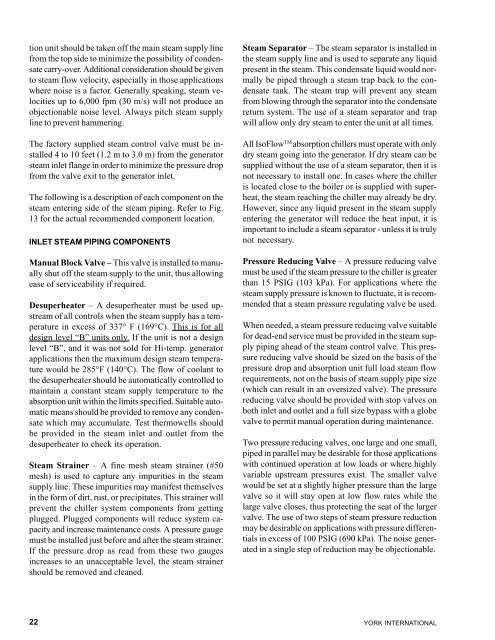
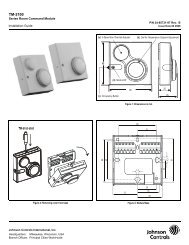
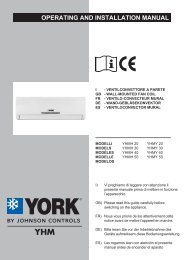



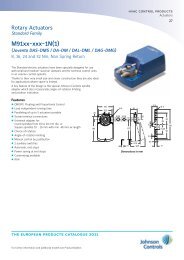


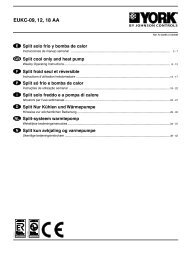
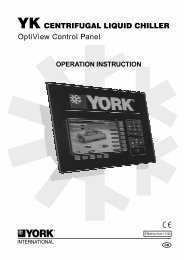
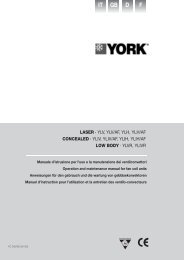
![[PDF] •Outdoor installation 4-5 - Johnson Controls](https://img.yumpu.com/10374038/1/184x260/pdf-ooutdoor-installation-4-5-johnson-controls.jpg?quality=85)
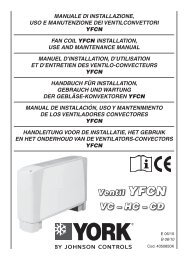
![[PDF] The European Products Catalogue 2012 - Johnson Controls](https://img.yumpu.com/3624903/1/184x260/pdf-the-european-products-catalogue-2012-johnson-controls.jpg?quality=85)